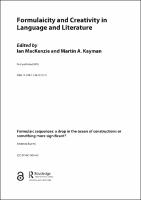Chapter 1 Formulaic sequences: a drop in the ocean of constructions or something more significant?
Proposal review
Abstract
This article investigates how formulaic sequences fi t into a
constructionist approach to grammar, which is a major post-
Chomskyan family of approaches to linguistic structure. The author
considers whether, in this framework, formulaic sequences represent
a phenomenon that is suffi ciently diff erent to warrant special status
or whether they might best be studied in terms of the larger set of all
constructions found in language. Based on data drawn from a large
corpus of Wikipedia texts, it is argued that it is extremely diffi cult
to form a distinct class of formulaic sequences without creating
highly arbitrary boundaries. On the other hand, based on existing
theoretical claims that formulaic sequences are the basis of fi rst
language acquisition, a marker of profi ciency in a language, critical
to the success of communicative acts and key to rapid language
processing, it is argued that formulaic sequences as constructions
are nevertheless signifi cant enough to be the focus of research, and a
theoretical category meriting particular attention. These fi ndings have
key repercussions both for research primarily interested in formulaic
language and phraseology as well as for construction grammatical
research.
Keywords
Fornulaic sequences; grammar; linguistic structureOCN
1082953416Publisher
Taylor & FrancisPublisher website
https://taylorandfrancis.com/Publication date and place
2018Imprint
RoutledgeClassification
Biography, Literature and Literary studies


 Download
Download